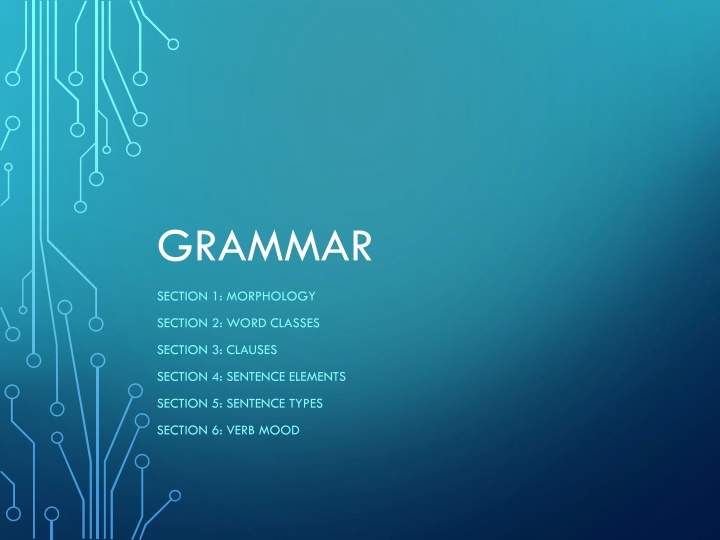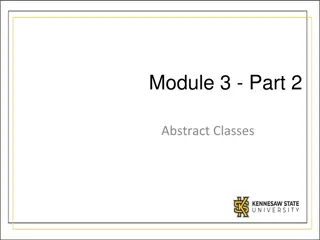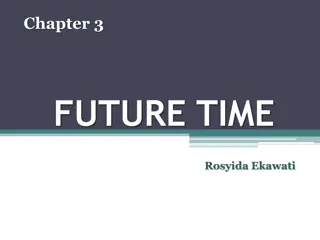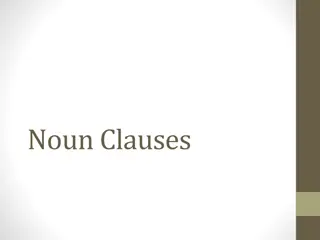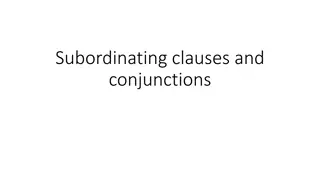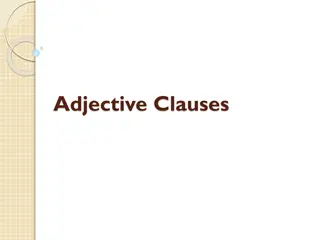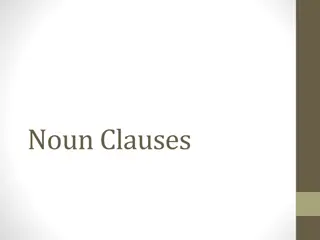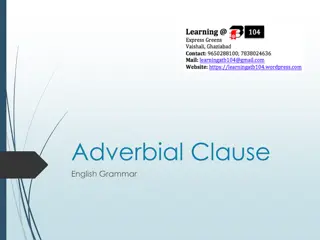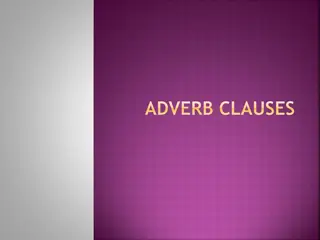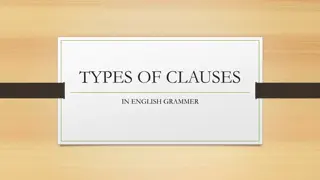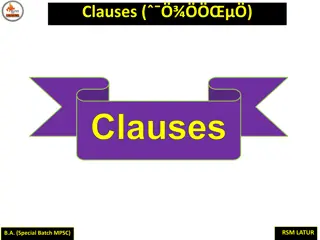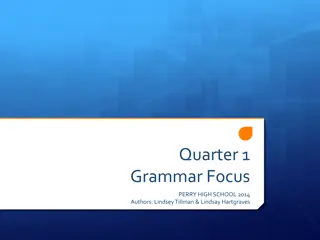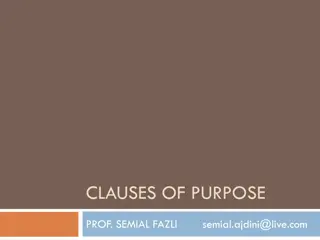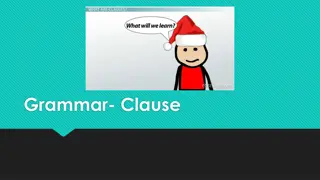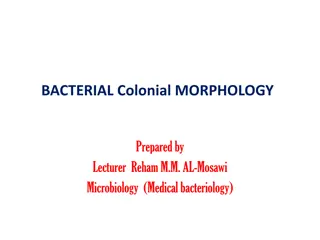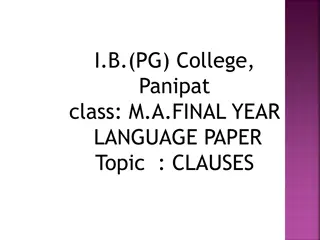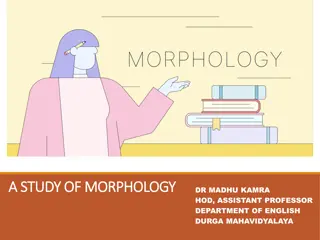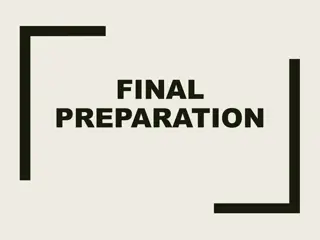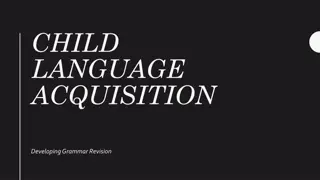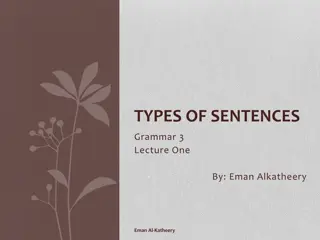Comprehensive Guide to Grammar: Morphology, Word Classes, Clauses, and More
Explore the fascinating world of grammar with insights into morphology, word classes, clauses, and sentence elements. Unravel the complexities of free and bound morphemes, learn about different word classes like nouns, and delve into the hierarchy of grammar. Discover the diverse aspects of language structure and enhance your understanding of verb mood and sentence types.
Download Presentation

Please find below an Image/Link to download the presentation.
The content on the website is provided AS IS for your information and personal use only. It may not be sold, licensed, or shared on other websites without obtaining consent from the author.If you encounter any issues during the download, it is possible that the publisher has removed the file from their server.
You are allowed to download the files provided on this website for personal or commercial use, subject to the condition that they are used lawfully. All files are the property of their respective owners.
The content on the website is provided AS IS for your information and personal use only. It may not be sold, licensed, or shared on other websites without obtaining consent from the author.
E N D
Presentation Transcript
GRAMMAR SECTION 1: MORPHOLOGY SECTION 2: WORD CLASSES SECTION 3: CLAUSES SECTION 4: SENTENCE ELEMENTS SECTION 5: SENTENCE TYPES SECTION 6: VERB MOOD
MORPHOLOGY SECTION 1
MORPHOLOGY Morphology is the study of word structure Morphemes are the smallest units of meaning within words. E.g. bird is one morpheme but birds is two morphemes because the s makes it plural
ANTIDISESTABLISHMENTARIANISM establish = give Church status of national institution + ment = the state/condition of (giving Church) + dis = removal/withdrawal of + arian = a person or thing that advocates + anti = opposed to + ism = the doctrine of (advocating) = the doctrine (ism) that opposes (anti) those who advocate (arian) the withdrawal (dis) of the condition (ment) of State recognition of an established Church
1. FREE MORPHEMES This unit of meaning can stand on its own in the form of complete word forms or stems e.g. ungraceful
2. BOUND MORPHEMES This unit of meaning has to be attached to a complete word form or stem through affixes: Prefix a bound morpheme before the stem of the word e.g. inadequate Suffix a bound morpheme after the stem of the word e.g. beautiful Bound morphemes change: Person e.g. I love cheese / She loves cheese Tense e.g. She loved me / He loves himself Possession e.g. Ian loves me / Ian s dog loves me Plural e.g. Lucy s cat loves me / Lucy s cats love me Comparison e.g. Her love for Richard is stronger that Anthony s but Julia s love for Richard is the strongest Word class e.g. colour (noun) vs. colourful (adjective)
WORD CLASSES SECTION 2
1. NOUNS Abstract refers to states, feelings and concepts that have no physical existence e.g. pain, happiness Concrete refers to objects that have physical existence. Divided into: Count concrete nouns that have a plural form e.g. chair(s) Mass concrete nouns that refer to a collection/group e.g. furniture Proper refers to names of people or places e.g. Susan, London Common refers to any noun which is not proper (e.g. concrete/abstract) Collective refers to a single group composed of multiple numbers e.g. a class of students
2. DETERMINERS Companion word class to nouns telling you the number (singular or plural) and/or status of the noun Article a determiner that denotes a singular form: Definite article the (specific) Indefinite article a/an (general) Possessive determiner which shows who the noun belongs to e.g. my/our/your Quantity determines the number of the noun e.g. several, many
3. PRONOUNS Demonstrative a pronoun that represents a thing or things. Divided into: Singular this (near), that (far) Plural these (near), those (far) Object a pronoun that usually appears as being affected by a verb process. Divided into: Singular me (first person), you (second person), him/her/them (third person) Plural us (first person), you (second person), them (third person) Possessive a pronoun that demonstrates ownership. Divided into: Singular my (first person), your (second person), his/her/their (third person) Plural our (first person), your (second person), their (third person)
PRONOUNS (CONTD) Reflexive a pronoun that is preceded or followed by the noun, adjective, adverb or pronoun to which it refers (its antecedent) within the same clause. Divided into: First person myself Second person his/her/themself Third person themselves Relative a pronoun used to connect a clause or phrase to a noun or pronoun. Divided into: Defining relative clauses that (subject), whom (object), whose (possessive) Non-defining relative clauses who (subject), whom (object), whose (possessive) [parenthetical commas] Subject a pronoun that usually occurs as the actor in a verbal process. Divided into: Singular I (first person), you (second person), he/she/they (third person) Plural we (first person), you (second person), they (third person)
4. ADJECTIVES Gradable these adjectives have 3 forms which can be graded upwards with the suffixes -er and -est or by adding more or most before the adjective: Absolute the base form of an adjective e.g. big, interesting Comparative the form of an adjective that designates comparison between two things e.g. bigger, more interesting Superlative expresses the highest level of the quality represented by an adjective e.g. biggest, most interesting Non-gradable there are some adjectives that are not gradable e.g. pregnant. You can t be more pregnant or most pregnant you are just pregnant.
NOUN PHRASE A group of words with a noun at the centre of it e.g. A magnificent double-fronted Victorian detached family house enjoying views across the Wetlands Head noun the main noun at the centre of a noun phrase Modifier any words that describes a noun (adjective/adverb/noun) Pre-modified modification that comes before the head noun (or before a phrase or clause) Post-modified modification that comes after the head noun (or after a phrase or clause)
5. VERBS Auxiliary assists the main verb: Modal auxiliary expresses degrees of possibility, probability, necessity or obligation e.g. can/might/will Primary auxiliary denotes change of tense e.g. had Copular a verb that takes a complement (usually a form of the verb to be used with an adjective for description) e.g. Our insects are important Primary be (am, are, is, was, were), have (have/had), do (do, does, did)
VERB TYPES Irregular change their form when changing from present to past tense e.g. swim > swam Regular take a regular -ed inflection when changing from present to past tense e.g. walk > walked. In some instances, verbs have double the final consonant of the base form e.g. commit > committed Inflection is when you add an ending to a verb e.g. ed/-ing to change tense or number. Present participle - a verb ending in ing e.g. playing Past participle - a verb ending in ed e.g. played Infinitive - a verb with to- positioned before it e.g. to play
VERB CATEGORIES Dynamic processes where there is a change in state over time e.g. paint, remove, eat Intransitive a verb process that has no object e.g. yawned, slept Transitive a verb process that has an object (most verbs) Non-finite a verb that has not been inflected e.g. to play (infinitive), watching (present participle) Finite a verb that has been inflected (most verbs) Material describes actions or events e.g. hit, run, play Mental describes perception, thought or speech e.g. think, believe, speak Relational describes states of being or are used to identify e.g. be, appear, seem Stative processes where the situation remains constant e.g. love, hold, believe
VERB PHRASE This is where auxiliary verbs are combined with main verbs e.g. He was running for President.
6. ADVERBS Manner describes how something happened e.g. She ate the cheese greedily. Time describes when something happened e.g. She bought the cheese yesterday. Place describes where something happened e.g. Put the cheese there. Frequency describes how often something happened e.g. She regularly buys cheese. Degree describes how much (the quantity) of something e.g. She really likes cheese.
7. PREPOSITIONS A word which shows how elements in a sentence or clause relate to each other in time or space e.g. in, on, under
8. CONJUNCTIONS Coordinating conjunctions these signal the start of a coordinate clause (a main clause joined to another main clause) e.g. He laughed like a drain and fell over backwards. Subordinating conjunctions these signal the start of a subordinate clause e.g. Because I love you, I ll buy you an ice cream.
CLAUSES SECTION 3
CLAUSE TYPES: Main clause a clause that can stand on its own grammatically e.g. Charlie unearthed some treasure Coordinate clause a clause beginning with a coordinating conjunction e.g. and jumped in the air Subordinate clause a clause that depends on the main clause to exist, doesn t make sense on its own e.g. while digging in the garden Non-finite subordinate clause a clause in which the verb is not finished and the tense is therefore not shown. The infinitive to- form or present participle is used e.g. To buy some cheese / Running down the road Embedded clause a clause which provides additional information to the main clause contained within commas e.g. Churchill, who was Prime Minister during the Second World War, enjoyed painting. The technique of putting information within commas/brackets is called parenthesis.
SENTENCES: Left-branching sentence a sentence containing the subordinate clause(s) before the main clause e.g. While in the garden, Harry found a golden egg. Periodic sentence a complex sentence in which the main clause is saved until the end e.g. The Prime Minister, who was usually late in the mornings, except on those occasions when she had been working all night, was already at her desk.
SENTENCE ELEMENTS SECTION 4
SVOCA Subject this normally performs the action of the sentence or clause and can be a single word/phrase Verb the action or state in the sentence or clause Object this normally receives the action and comes after the verb Complement a clause element that tells you more about the subject or object Adverbial part of a clause or sentence which identifies where, when, how modifying the verb
DIRECT OBJECT VS. INDIRECT OBJECT Direct object the thing acted upon by the subject Indirect object the thing that receives the action Example: 1) Mary gave Tom Brown (IO) Dick Turpin (DO) 2) Mary gave Tom Brown (DO) to Dick Turpin (IO)
IDENTIFYING SVOCA The frog greedily ate the fly. The frog ate a fly yesterday. On the pond, the frog ate a fly. You made the frog greedy. The frog cried.
ACTIVE & PASSIVE VOICE Active Voice clause construction where the subject is also the actor (they are doing the verb) E.g. Tony kicked the ball. Passive Voice clause construction where the subject is not the actor (they are the one receiving the verb). There is a focus on the goal in the passive voice. E.g. The ball was kicked by Tony.
SYNTAX Syntax refers to the order in which the elements of the sentence are placed. For example, why do we structure sentences using the SVOCA system? When and why would we use the active vs. the passive voice?
SENTENCE TYPES SECTION 5
1. MINOR A minor sentence does not contain a subject-verb-object construction making it technically ungrammatical but does make pragmatic sense on its own. E.g. Welcome to Reading.
2. SIMPLE A simple sentence only contains one clause using the subject-verb-object construction. E.g. I ate the apple.
3. COMPOUND A compound sentence has two or more clauses usually joined to the main clause with coordinating conjunctions (and/but). More than one thing is happening or being expressed and each clause has the same weight or importance. E.g. Charlie unearthed some wonderful treasure and flogged it to a museum.
4. COMPLEX A complex sentence has two or more clauses, one of which is a subordinate clause using subordinating conjunctions (by/because/when/although). The clause connected by one of these conjunctions can t stand on its own and make sense. In a complex sentence more than one thing is happening or being expressed but one event is thought to be more important than the other. E.g. Charlie unearthed some wonderful treasure while digging in the garden.
5. COMPOUND-COMPLEX A compound-complex sentence has three or more clauses, at least one of which will be a subordinate clause, and one of which will be a coordinate clause. E.g. I stopped because the man was just lying there in the road and asked if he was ok.
VERB MOOD SECTION 6
1. DECLARATIVE A declarative is a statement of fact or feeling E.g. He shut the window. These will be more common than any other kind of sentence in informational texts and can show assurance.
2. INTERROGATIVE An interrogative is a question E.g. Did he shut the window? Interrogatives require a reply, maintain conversation, can illustrate power and can be used as a persuasive device. Tag questions are interrogative clauses added to the end of a declarative to make it into a question e.g. We re meeting for lunch today, aren t we?
3. IMPERATIVE An imperative is an order or command E.g. Shut the window now! Imperatives are found in great quantities in advisory texts. They are found in bald, unsoftened forms e.g. Pick that up! or more frequently in softened, mitigated forms e.g. Please could you pick that up for me.
